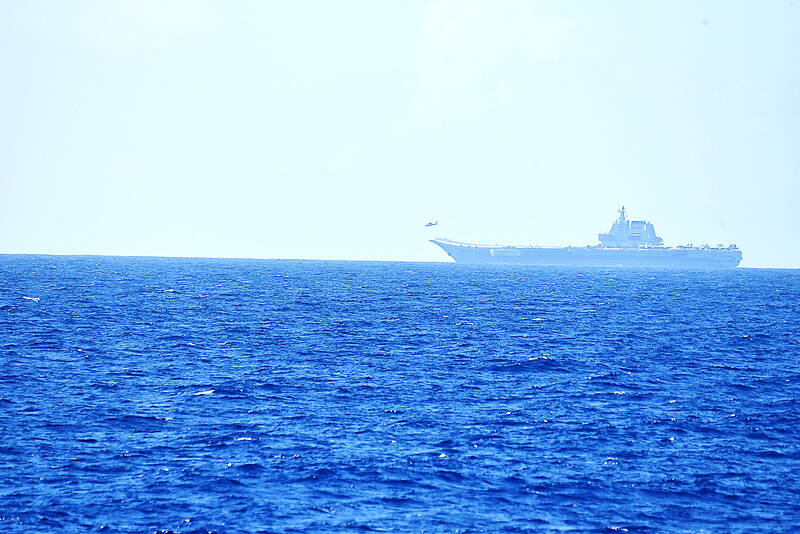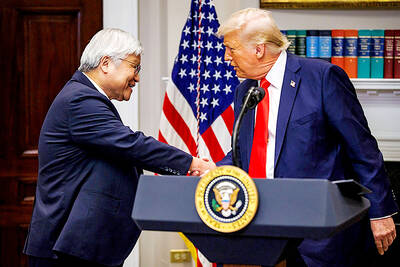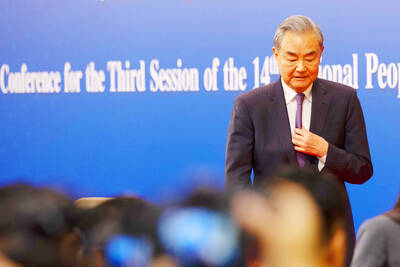China sailed its aircraft carrier the Shandong through waters southeast of Taiwan into the western Pacific Ocean for a long-range exercise yesterday, the Ministry of National Defense said in a news release.
The ministry said it keeps close tabs on Chinese military activity through joint intelligence and surveillance.
Early yesterday it tracked the Shandong as it passed through the waterway 60 nautical miles (111km) southeast of Oluanpi (鵝鑾鼻), Taiwan’s southernmost tip, and headed east into the western Pacific Ocean for a long-range training session in the area.

Photo: Reuters / Joint Staff Office of the Japanese Ministry of Defense
The Shandong, the second of China’s two aircraft carriers, was the first to be domestically built, after being commissioned in 2019.
The ministry said it also tracked a total of 13 military aircraft and drones, including J-16s, Su-30s and Shaanxi KJ-500s, flying near Taiwan’s airspace from 5:40am.
Eleven of the 13 crossed the median line of the Taiwan Strait and entered the southwestern part of Taiwan’s air defense identification zone (ADIZ), it said.
From 6am on Sunday to 5am yesterday, 26 People’s Liberation Army (PLA) warplanes and 13 warships were detected around Taiwan, the ministry said.
Of the 26 aircraft, 11 crossed the median line and entered the southwestern part of Taiwan’s ADIZ.
“The military is closely monitoring the situation and has tasked aircraft, navy vessels and land-based missile systems to respond,” the ministry said.
Chieh Chung (揭仲), an associate research fellow at the National Policy Foundation in Taipei, said that continued recent incursions by PLA aircraft were meant to pressure and provoke Taiwan, and were in response to the Taiwan Strait transit by a US destroyer and a Canadian frigate made on Saturday.
The US Navy had said that the transit “demonstrates the commitment of the United States and our allies and partners to a free and open Indo-Pacific” region.
In response, China on Saturday said its troops were “on constant high alert.”
The US and Western allies have increased freedom of navigation crossings of the Taiwan Strait and the disputed South China Sea to reinforce that both are international waterways, angering Beijing.
Additional reporting by AFP

CRITICAL MOVE: TSMC’s plan to invest another US$100 billion in US chipmaking would boost Taiwan’s competitive edge in the global market, the premier said The government would ensure that the most advanced chipmaking technology stays in Taiwan while assisting Taiwan Semiconductor Manufacturing Co (TSMC, 台積電) in investing overseas, the Presidential Office said yesterday. The statement follows a joint announcement by the world’s largest contract chipmaker and US President Donald Trump on Monday that TSMC would invest an additional US$100 billion over the next four years to expand its semiconductor manufacturing operations in the US, which would include construction of three new chip fabrication plants, two advanced packaging facilities, and a research and development center. The government knew about the deal in advance and would assist, Presidential

‘DANGEROUS GAME’: Legislative Yuan budget cuts have already become a point of discussion for Democrats and Republicans in Washington, Elbridge Colby said Taiwan’s fall to China “would be a disaster for American interests” and Taipei must raise defense spending to deter Beijing, US President Donald Trump’s pick to lead Pentagon policy, Elbridge Colby, said on Tuesday during his US Senate confirmation hearing. The nominee for US undersecretary of defense for policy told the Armed Services Committee that Washington needs to motivate Taiwan to avoid a conflict with China and that he is “profoundly disturbed” about its perceived reluctance to raise defense spending closer to 10 percent of GDP. Colby, a China hawk who also served in the Pentagon in Trump’s first team,

SEPARATE: The MAC rebutted Beijing’s claim that Taiwan is China’s province, asserting that UN Resolution 2758 neither mentions Taiwan nor grants the PRC authority over it The “status quo” of democratic Taiwan and autocratic China not belonging to each other has long been recognized by the international community, the Mainland Affairs Council (MAC) said yesterday in its rebuttal of Beijing’s claim that Taiwan can only be represented in the UN as “Taiwan, Province of China.” Chinese Minister of Foreign Affairs Wang Yi (王毅) yesterday at a news conference of the third session at the 14th National People’s Congress said that Taiwan can only be referred to as “Taiwan, Province of China” at the UN. Taiwan is an inseparable part of Chinese territory, which is not only history but

INVESTMENT WATCH: The US activity would not affect the firm’s investment in Taiwan, where 11 production lines would likely be completed this year, C.C. Wei said Investments by Taiwan Semiconductor Manufacturing Co (TSMC, 台積電) in the US should not be a cause for concern, but rather seen as the moment that the company and Taiwan stepped into the global spotlight, President William Lai (賴清德) told a news conference at the Presidential Office in Taipei yesterday alongside TSMC chairman and chief executive officer C.C. Wei (魏哲家). Wei and US President Donald Trump in Washington on Monday announced plans to invest US$100 billion in the US to build three advanced foundries, two packaging plants, and a research and development center, after Trump threatened to slap tariffs on chips made